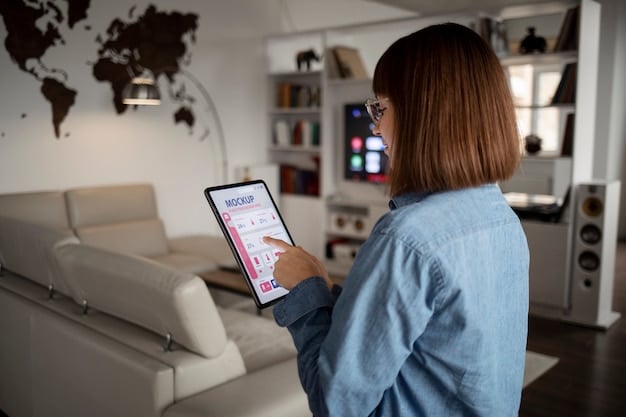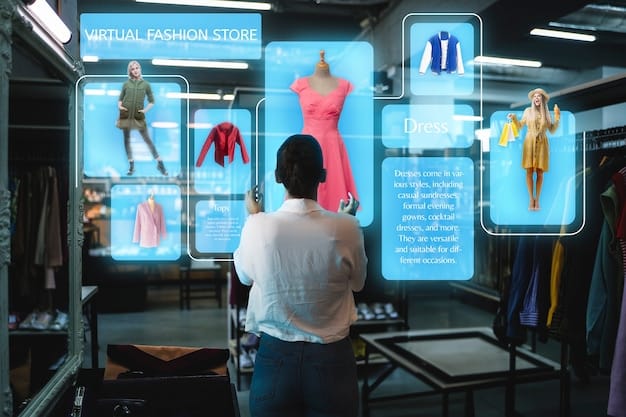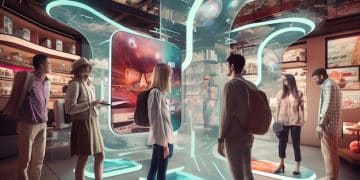Augmented Reality in US Retail: Transforming the Shopping Experience

Augmented Reality (AR) is revolutionizing the US retail industry by enhancing customer engagement, providing immersive shopping experiences, and driving sales through innovative applications like virtual try-ons and interactive product visualizations.
The US Retail Industry: How Augmented Reality is Transforming the Shopping Experience is a growing trend, changing the way consumers interact with products and brands. AR is bridging the gap between online and offline shopping, offering immersive and personalized experiences that drive engagement and sales.
Augmented Reality: A New Era for US Retail
Augmented reality (AR) is rapidly changing the landscape of the US retail industry. By overlaying digital information onto the real world, AR enhances the shopping experience, offering customers new ways to interact with products and brands.
This technology is not just a novelty; it’s a powerful tool that retailers are using to drive sales, increase customer engagement, and gain a competitive edge in an increasingly digital world.
The Rise of AR Applications in Retail
AR applications in retail are diverse, ranging from virtual try-ons to interactive product displays. These applications provide customers with valuable information and enhance their decision-making process.
- Virtual Try-Ons: Allow customers to virtually try on clothing, accessories, and makeup before making a purchase.
- Interactive Product Displays: Bring products to life with 3D models and animations, providing customers with a more engaging experience.
- In-Store Navigation: Help customers navigate large retail spaces, locate products, and find the best deals.

Retailers are leveraging these AR applications to create unique and memorable shopping experiences that differentiate them from the competition. By offering interactive and personalized experiences, retailers can build stronger relationships with their customers and drive brand loyalty.
In conclusion, augmented reality is transforming the US retail industry by providing customers with immersive and engaging shopping experiences. From virtual try-ons to interactive product displays, AR applications are helping retailers drive sales, increase customer engagement, and gain a competitive edge.
Enhancing Customer Engagement with AR
Customer engagement is crucial for the success of any retail business. Augmented reality offers retailers new ways to engage with their customers, providing them with valuable information and enhancing their overall shopping experience.
By offering interactive and personalized experiences, retailers can build stronger relationships with their customers and drive brand loyalty.
Personalized Shopping Experiences
AR enables retailers to offer personalized shopping experiences that cater to individual customer preferences. By analyzing customer data and preferences, retailers can tailor AR experiences to meet specific needs.
For example, an AR app could recommend products based on a customer’s past purchases or browsing history. This level of personalization can significantly enhance the shopping experience and drive sales.
Immersive Brand Experiences
AR can also be used to create immersive brand experiences that transport customers into the world of a particular brand. By offering interactive and engaging content, retailers can build stronger emotional connections with their customers.
These immersive experiences can range from virtual tours of manufacturing facilities to interactive games that showcase the brand’s history and values. The goal is to create a memorable and engaging experience that resonates with customers and drives brand loyalty.
In conclusion, augmented reality is enhancing customer engagement in the US retail industry by providing personalized shopping experiences and immersive brand interactions. These experiences help retailers build stronger relationships with their customers and drive brand loyalty.
Driving Sales with Augmented Reality
One of the primary goals of any retail business is to drive sales. Augmented reality offers retailers a powerful tool for increasing sales by enhancing the shopping experience and providing customers with valuable information.
By offering interactive and engaging experiences, retailers can encourage customers to make purchases and increase their overall sales revenue.

Reducing Return Rates
AR can help reduce return rates by providing customers with a more accurate representation of products before they make a purchase. For example, virtual try-on applications allow customers to see how clothing or accessories will look on them before they buy.
This reduces the likelihood that customers will be dissatisfied with their purchase and return the item. By reducing return rates, retailers can save money on shipping and handling costs and increase their overall profitability.
Increasing Conversion Rates
AR can also increase conversion rates by providing customers with a more engaging and informative shopping experience. By offering interactive product displays and personalized recommendations, retailers can encourage customers to make a purchase.
- Enhanced Product Visualization: AR allows customers to visualize products in their own environment, providing them with a better understanding of the product’s size, shape, and color.
- Improved Decision-Making: AR provides customers with valuable information that helps them make informed purchasing decisions.
- Increased Confidence: AR increases customers’ confidence in their purchasing decisions, making them more likely to complete the transaction.
In conclusion, augmented reality is proving helpful in driving sales in the US retail industry by reducing return rates and increasing conversion rates. These improvements can significantly improve retailers’ profitability and overall business performance.
Challenges and Opportunities in AR Implementation
While augmented reality offers numerous benefits to the US retail industry, there are also challenges that retailers must overcome to successfully implement this technology. These challenges include high implementation costs, technical complexities, and customer adoption rates.
However, the opportunities presented by AR far outweigh these challenges, making it a worthwhile investment for retailers looking to stay ahead of the curve.
Addressing Technical Complexities
Implementing AR requires a significant investment in technology and expertise. Retailers must have the infrastructure in place to support AR applications, including high-speed internet connections and powerful mobile devices.
They must also have the technical expertise to develop and maintain AR applications. This can be a challenge for smaller retailers with limited resources.
Overcoming Customer Adoption Barriers
Another challenge is customer adoption. While many customers are excited about the potential of AR, some are hesitant to use the technology. This may be due to concerns about privacy, security, or simply a lack of familiarity with the technology.
Retailers must address these concerns by providing clear and concise information about how AR works and how it can benefit customers. They must also ensure that AR applications are user-friendly and easy to navigate.
Despite these challenges, the opportunities presented by AR are significant. By overcoming these challenges, retailers can unlock the full potential of AR and gain a competitive edge in the dynamic US retail market.
Future Trends in Augmented Reality for Retail
The future of augmented reality in the US retail industry is bright, with numerous exciting trends on the horizon. As the technology continues to evolve, we can expect to see even more innovative and engaging AR applications emerge.
These trends will further transform the shopping experience and provide retailers with new ways to connect with their customers.
Integration with AI and Machine Learning
One of the key trends is the integration of AR with artificial intelligence (AI) and machine learning (ML). This integration will enable retailers to offer even more personalized and relevant AR experiences.
For example, AI and ML can be used to analyze customer data and preferences to provide personalized product recommendations and tailored AR experiences. This level of personalization can significantly enhance the shopping experience and drive sales.
Expansion into New Retail Sectors
Another trend is the expansion of AR into new retail sectors. While AR has already made significant inroads in the fashion, beauty, and home decor sectors, we can expect to see it expand into other areas such as grocery, automotive, and healthcare.
This expansion will further transform the shopping experience and provide customers with new ways to interact with products and services.
In conclusion, the future of augmented reality in the US retail industry is promising. With integration of AI, machine learning and expansion across retail sectors, AR is poised to transform the shopping experience and take retail to new heights.
Success Stories: AR in Action
Several retailers in the US have already successfully implemented augmented reality to enhance the shopping experience and drive sales. These success stories provide valuable insights into how AR can be used effectively in different retail settings.
Let’s take a look at a couple of notable examples.
Sephora Virtual Artist
Sephora’s Virtual Artist app allows customers to virtually try on makeup products using AR technology. Customers can experiment with different shades and styles without physically applying the products.
This has significantly enhanced the shopping experience and increased customer engagement. It also reduces product returns by helping customers make more informed purchasing decisions.
IKEA Place
IKEA Place app allows customers to visualize how furniture would look in their own homes using AR. Customers can virtually place furniture in their living rooms, bedrooms, or any other space and see how it fits with their existing decor.
- Improved Decision Making: By seeing the furniture in their own homes, customers can more easily decide whether or not to make a purchase.
- Reduced Returns: Customers are less likely to return furniture that doesn’t fit or match their decor.
- Increased Confidence: The app increases customers’ confidence in their purchasing decisions.
These success stories demonstrate the power of augmented reality to transform the shopping experience and drive sales. By offering interactive and personalized experiences, retailers can build stronger relationships with their customers and gain a competitive edge.
| Key Point | Brief Description |
|---|---|
| 👓 Virtual Try-Ons | Customers can virtually try products like glasses and makeup before buying. |
| 🏠 Furniture Visualization | AR apps show how furniture fits in a customer’s home before purchase. |
| 📈 Sales Increase | AR enhances the shopping experience, leading to higher conversion rates and sales. |
| 🤖 AI Integration | AR combined with AI offers personalized shopping experiences for customers. |
FAQ
▼
Augmented reality in retail overlays digital information onto the real world, enhancing the shopping experience through virtual try-ons, interactive displays, and more.
▼
AR provides personalized, immersive, and interactive shopping experiences, allowing customers to engage with products in new and exciting ways, increasing satisfaction.
▼
Yes, AR can significantly drive sales by reducing return rates with virtual try-ons and increasing conversion rates through engaging visualizations.
▼
The main challenges include the initial high costs, technical complexities, and ensuring widespread customer adoption despite potential hesitancy.
▼
Expect greater AI and machine learning integration, which will personalize AR experiences further, plus, expansion of AR into the retail sectors like grocery and automative .
Conclusion
In conclusion, augmented reality is transforming the US retail industry by providing customers with immersive, personalized, and engaging shopping experiences. While there are challenges to overcome, the benefits of AR are clear: increased sales, improved customer engagement, and a competitive edge in an increasingly digital world. Retailers who embrace AR are well-positioned to thrive in the future.





